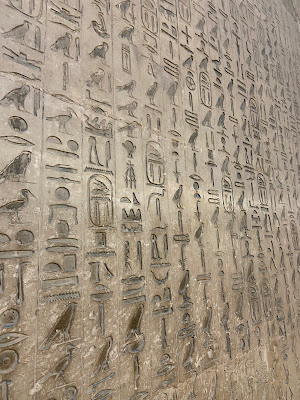Egyptian Experience - Day Two
Day One Recap
Yesterday’s visit to the Egyptian
Museum had opened the window to experience the enchanting world of an ancient
civilisation. On hindsight, if there is one artefact that a serious traveller
must absolutely embrace, it is the Narmer Palette. Dating back to around 3100
BCE. It is a ceremonial engraving that depicts King Narmer, who is believed to
have unified Upper and Lower Egypt, marking the beginning of the First Dynasty
and the dawn of Pharaonic Egypt. There are numerous iconographic
characteristics appearing on the Narmer Palette that remain staples in Egyptian
art for the following three millennia. The pose Narmer takes where he grasps an
enemy by the hair and prepares to smash his skull with a mace, was repeated by
Pharaoh after Pharaoh and other rulers through the Roman era more than 3000
years later. We would keep seeing it in mural after mural over the next few
days.
Day Two
Day 2 began very early. As per my
notes, we left our hotel at 0725 after a hearty breakfast. It was the day to
experience the Pyramids – the pièce de résistance of the Egyptian culture. And
we started at where it all began – Saqqara.
Saqqara and Dahshur Necropolis
55 minutes after leaving the
hotel, I stood awestruck gazing at the oldest stone monument in the world. It
was bathed in sunlight. The light was perfect to go click click click. The
stepped pyramid was built for the Pharaoh Djoser (3rd dynasty)
around 2670 BC by his chief architect Imhotep. Before that mausoleums were trapezoidal
shaped Mastabas. – rectangular base, flat roof, sloping sides. The genius of
Imhotep lay in stacking 6 progressively smaller Mastabas one over the other to
form the stepped pyramid. Nothing on this scale had ever been tried before and
I feel it deserves as much appreciation as the Grand Pyramid at Giza. It marked
the transition from mudbricks to stone in Egyptian civilisation. The stones
used were locally quarried, roughly cut limestone. Most aptly, there is a
temple dedicated to Imhotep, built during the Ptolemaic period (3rd
Century BC). Imhotep was deified as a god of wisdom, medicine, and architecture,
and the temple functioned as a healing centre.
The Bent Pyramid built under
Pharaoh Sneferu (circa 2600 BC, 4th Dynasty) is an important milestone in the
evolution of the Pyramids. Initially, it was constructed at a steep angle of 54
degrees, but due to structural instability, the angle was reduced to 43 degrees
midway. This abrupt change resulted in the distinctive “bent” profile. The
lessons learned here were crucial for later pyramid construction. Also built
under Sneferu, the Red Pyramid was the first successfully completed
smooth-sided pyramid. Constructed at a uniform 43-degree angle, it demonstrated
a perfected pyramid design. This structure directly influenced the famous
pyramids at Giza.
The Pyramid of Unas (5th
dynasty), gave us the first of our many subterranean experiences in Egypt. This
is notable for the first religious inscriptions, providing insights into the
Egyptian beliefs about afterlife. We also crawled into the Mastaba of Kagemni,
a vizier, to look at the carvings featuring scenes of fishing, farming,
feasting and other activities from daily life.
Memphis Museum
Next on the agenda was the open-air
Museum at Memphis, the ancient capital of Egypt during the old kingdom (circa 3100
BC). There used to be a temple here of Ptah, the god of craftsmen and artisans.
The city and the temple have disappeared without a trace and the open-air
museum displays a collection of archaeological finds from Memphis. Two statues will
remain etched in our memories for a long time. One of them is a Sphinx weighing
80 tons and carved from a single block of alabaster; the features are well-preserved
even now. The other one is a 10-metre-long colossal statue of Ramses-II. It was
discovered buried face down, because of which the features are astonishingly
intact. The colossus is laid down in a pavilion provided with a viewing balcony
to appreciate its grandeur. In an interesting way to engage the visitor, the
museum challenges the visitor to spot and count all the cartouches on the
statue. Cartouches are bullet-shaped frames in which the Pharaoh’s names are
inscribed in hieroglyphics. But for these cartouches on various murals, it
would not have been possible to identify the concerned Pharaoh.
Coptic Cairo
After lunch, we travelled 20 km
and leapfrogged 3 millennia to enter Coptic Cairo. The term “Coptic” has a
Greek origin and referred to Egypt as a whole, but subsequently acquired a
narrow definition for the Christian community. Christianity came to Egypt
around 43 AD brought by the evangelism of St. Mark. Today 5-15 % of Egypt’s
population are Christians, the wide variation telling its own story. We visited
2 churches in Coptic Cairo. The first
one has the fanciful popular name of “Hanging Church” because from afar it
appears to be pinned to the walls of a Roman fortress. The most important
feature of this church built in 3rd C Is the wooden roof shaped like
Noah’s ark. The relic of the Virgin Mary’s Girdle is displayed inside the
church. The second church, popularly known as Cavern Church has a deeper significance
as it is supposed to be built over the cave where the holy family of Baby Jesus
and his parents took refuge for 3 months. A plaque commemorating this crypt and
also the well from which the family drank can be seen in the church. We also
breezed in and out of the beautiful Ben Ezra Synagogue, where photography is
forbidden for some unfathomable reason. An imposing building houses the Coptic
Museum, which we skipped for the paucity of time. With cobblestoned alleys
lined with overhanging balconies, dimly lit shrines and souvenir shops, Coptic
Cairo has a quaint ambiance that merits at least double the time that we had
budgeted.




















Comments
Post a Comment